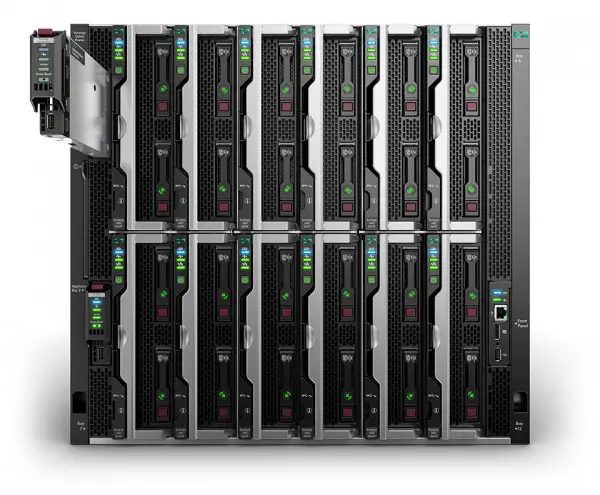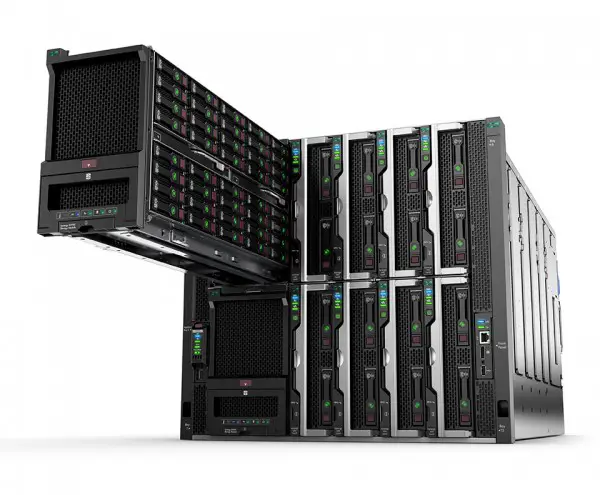The new Hewlett Packard Enterprise introduced its first major new platform last week during HPE Discover in London. The new platform is named Synergy and is based around the idea of composable infrastucture – hardware that can be programatically composed into the desired form for a specific use case. The Synergy platform follows up on the Project Synergy concept HP introduced during the June Discover event in Las Vegas. While HPE has been working with third-parties to get support for its API for composable infrastructure, it was also creating the new generation of hardware needed to power the concept.
HPE staff says that Synergy is a completely new hardware platform built to enable the composable concept. In many ways, the Synergy platform looks like a next-generation C7000 blade chassis. There are quick, noticeable differences.

HPE Synergy 12000 Frame with 12 compute nodes and the Synergy Composer module pulled out
Synergy trims down the number of compute slots from 16 to 12. When asked why – HPE execs told me that the goal of the Synergy platform was to power compute for the next 10 years and that meant flexibility not density as a primary concern. Some peer bloggers scoffed at the 10 year future for the platform, but as an HP customer, that is the lifetime I have received from my existing C7000 BladeSystems as a platform, which are approaching a 10 year anniversary.
With the Synergy platform, there are some terminology changes. HPE engineers told me that they are moving away from the term blade and refer to the servers as compute nodes. The interconnects become the fabric in the Synergy platform. And lastly, the core chassis that everything plugs into is known as a frame.
In an attempt to future-proof the new platform, HPE created a mid-plane in the frame that is photonics capable – meaning, when photonics come to market, there are pathways to utilize them in this chassis. The midplane has also been simplified, according to HPE engineers and there is a bit more breathing room mean for cooling around the servers. Utilizing the additional space, the new compute nodes will have the same number of DIMM slots as their rackmount counterparts, allowing them to stack as much RAM and removing any downside to the converged platform.
Solving issues of scale
While the physical hardware largely resembles the C7000 BladeSystem chassis, HPE set out to solve several of the problems that exist with the C7000 when trying to create a composable infrastructure platform.
First, Synergy embraces HPE OneView as the management platform, removing the onboard administrator management. OneView lives within the Synergy Composer, a management appliance that exists in one of the two appliance bays located on the left side of each of the Synergy platform frame.
Second, Synergy scales better using OneView by allowing a single Synergy Composer to manage up to 20 frames. The Frame Link Module is built to connect frames over greater distances over normal twisted pair, copper cables (CAT5, CAT6, etc.). For redundancy, another Synergy Composer can be placed into an appliance bay in a different frame and the pair mirror one another with failover capabilities.
Solving issues of the OS
Third, Synergy introduces an all-new Synergy Image Streamer – another type of appliance module that sits in an appliance bay – allows for all the boot images required for systems to be stored centrally and managed. The idea behind Image Streamer is to bring many of the same benefits of virtualization to a physical world. Images are stored in the streamer and combined into a Server Profile which includes all of the BIOS settings, WWN and MAC address settings and . The bootable image is presented to the compute node over iSCSI to allow for boot. The complexity of the iSCSI configuration is masked away from the user and handled by Synergy Composer. A second Image Streamer can also be added to another frame for redundancy and the two mirror one another.
The Image Streamer squarely targets OS models without persistent data. Currently, Linux, VMware ESXi and Docker are currently supported OS models with Image Streamer. The boot image is stored as a Golden Master in the Image Streamer and this golden image is forked and combined with a ‘personality’ containing the IP address, hostname and other settings that are applied against the image at boot. The personality can include necessary steps to configure the OS, such as esxcli commands to perform configuration after boot. It is worth noting that Windows is not currently on the list of supported OSes. To patch your OS, you boot the golden image, integrate your changes and then recommit the golden image. At this point, you are able to recompose all of your assigned compute nodes, reboot them and you’re instantly patched. If a patch causes an issue, you are able to roll back to previous state just as easily with a reboot.
Using the Image Streamer doesn’t prevent users from running traditional workloads – like local booting or boot from SAN Windows cluster nodes with SAN storage. Traditional servers can be configured and setup next to Image Streamer profiles. HPE engineers see the Image Streamer as the ultimate flexiblity
Improving connectivity
Another major change is around the fabric and connectivity of the Synergy platform. Since the storage and network have converged even in the C7000 years using FlexFabric modules, Synergy continues this converged theme by utilizing the same Virtual Connect technology of the C7000 and extending it so that a single controlling Virtual Connect module in a one frame can be physically connected to child fabric modules in additional frames. The single Virtual Connect allows for centralized control of Virtual Connect over multiple chassis – or frames. The modules can be daisy chained to simplify management and mobility between compute nodes. The benefit is flexibility to reassign the same server profile to a compute note in a wider range of chassis. The C7000 would almost certainly limit you to blades in the same chassis as reassignment options – due to boundaries of the WWN and MAC ranges.

In addition to Virtual Connect, there is also a 12Gb SAS storage module that allows connectivity to Synergy D3940 Storage Modules located in the frame, like the one pulled out in the picture above. The new storage module can be equipped with up to 40 small form factor drives that can be grouped and presented to the compute nodes in the same frame. This would allow disks to be attached and presented as local storage or served up as a StoreVirtual VSA within an ESXi host.
Ship date & pricing
Synergy platform is expected to go on sale at the end of first quarter in 2016 and ship to customers during second quarter of 2016. Pricing has not been announced.
For deployments utilizing the Image Streamer with full redundancy, a minimum of three frames will be required, according to HPE engineers. This allows the necessary management NICs for redundancy with the Image Streamer and redundancy with the Composer appliances. This aligns the Synergy platform with larger environments that need flexibility and the ability to shift and adapt workloads often and on the fly.
